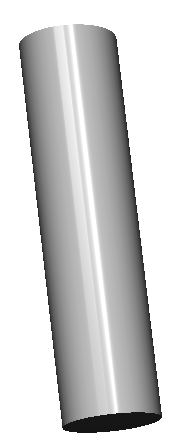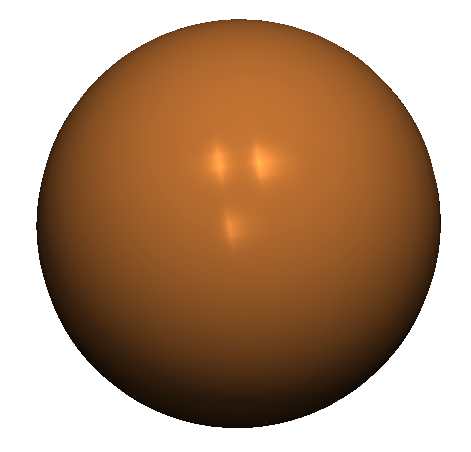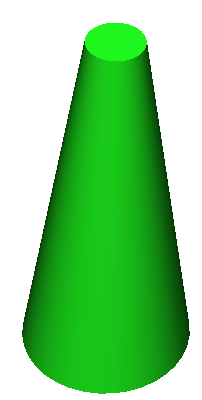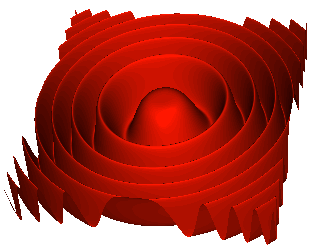- Piecewise linear approximation is a tool we can use on the CPU or
on the GPU (in tessellation and/or geometry shaders). Note that we must generate both
the 3D vertex coordinates and the corresponding 3D normal vectors for each vertex. Again,
the cryph utilities can go a long way towards simplifying the code required for these.
- Quadric surfaces (most commonly, cylinders, spheres, and cones):



The required code for all three of these is a straightforward extension of what we saw in the colorwheel example. Computing the normal vectors for the cylinder and the sphere is straightforward. Computing the normal to a cone is only slightly more complex and can be done in a couple of different ways. For example, the normal at a point, P, to a cone whose vertex is V and whose axis vector is a is just the component of a perpendicular to (P - V). - Terrain surfaces (aka height or elevation surfaces):

These are surfaces that can be written in the form:z = f(x, y) They can also be written as an implicit equation:F(x, y, z) = f(x, y) - z = 0 Using the implicit equation, we can express the normal vector at a point on the surface as: normal(x, y, z) = ∇F(x, y, z).You usually create such a surface over a rectangular domain in the xy-plane, something like:
for (double x=xmin ; x<=xmax ; x+=dx) for (double y=ymin ; y<=ymax ; y+=dy) { cryph::AffPoint p(x, y, f(x,y)); cryph::AffVector normal(gradientOfF(x,y)); // store p and normal in their respective VBOs }The surface above was generated from z = f(x, y) = cos(x2 + y2).Recalling your calculus days, you implement gradientOfF(x,y) = ∇(f(x,y) - z) = ((∂f/∂x)(x,y), (∂f/∂y)(x,y), -1).
In the case of our surface above, ∇(f(x,y) - z) = ((∂f/∂x)(x,y), (∂f/∂y)(x,y), -1) = (-2xsin(x2 + y2), -2ysin(x2 + y2), -1).
Sometimes height surfaces are only known discretely. The most common example could be characterized as a 2D array representing a grid covering some region of the xy-plane in which we know the height only at each point of the array. This structure is easily mapped to a collection of OpenGL triangle strips. The normal at each vertex could be computed either as the average of all triangle normals sharing the vertex, or as the normal to a single triangle. As an example of the latter, the normal at vertex [r][c] might come from the triangle with vertices [r][c], [r+1][c] and [r][c+1], with proper care being taken for boundary cases.
- Quadric surfaces (most commonly, cylinders, spheres, and cones):
- Concrete subclasses of ModelView/SceneElement can be constructed using the BasicShape and BasicShapeRenderer classes. See the full documentation and examine the room example in SampleProgramSet3 that uses these classes. BasicShape instances create building block objects like spheres, blocks, and cones. Class BasicShapeRenderer is a "renderable object" that can then render these shapes in some scene. Recall the discussion in 3D Modeling 101 where we explained the structure of render methods that establish the environment and then call "renderXxx" methods – either their own or those of other classes.